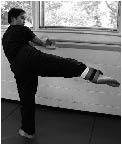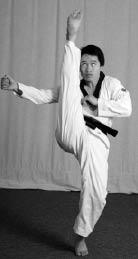Complete Kicking (13 page)
Authors: Turtle Press

SPORT APPLICATION
Use a quick, light raising kick to block an opponent’s high front kick or inside crescent kick.
SELF-DEFENSE APPLICATION
Raising kick is a good way to improve your axe kick by dynamically stretching the hamstring muscles.
In this unorthodox self-defense application, you can throw a raising kick against an assailant who attacks from behind, striking with the the ball of the foot.
common mistakes
MISTAKE 1: Hunching the upper body.
SOLUTION: The most common cause of poor posture, especially in the torso, is excessive muscular tension, either because you are trying to kick too high or too hard. To remedy this, keep your upper body erect and relaxed while you raise your leg smoothly and without power.
MISTAKE 2: Raising up on the toes. This is also usually caused by kicking too high or too hard for your skill level and will often lead to another common mistake: lowering your upper body backwards.
SOLUTION: Relax and kick at an attainable height without power. Reduce muscle tension by having realistic expectations. Bend your standing leg (knee) slightly to eliminate the strain in your hamstrings that leads to raising up on your toes.
• remember
1. Keep your posture upright.
2. Relax your shoulders and neck.
3. Advance progressively.
4. Raise your leg smoothly, without power.
5. Exhale as you raise your leg.
Bending your standing knee slightly will allow you to kick higher while maintaining good posture. Keep your arms around your kicking leg for balance.
• avoid
1. Struggling to kick higher than your present skill level allows
2. Trying to progress too quickly
3. Hunching your upper body
4. Lifting your standing heel excessively
5. Leaning your body backward
timing & breathing
Breathing is key to converting internal energy to power. When your breathing and technique are in sync, your kick carries maximum force.
Breathe naturally as you move and your body will tell you when to breathe in and out. Here are some guidelines to help you get started:
1. For direct kicks, inhale before kicking and exhale when you kick. At the moment of impact, exhale sharply while tightening your lower belly.
2. For stepping kicks, inhale when you raise your leg, step forward, turn around, or jump. Exhale when you kick.
BOTTOMLINE: Power comes with exhalation at the moment of impact.
HOW TO KICK WELLwith your weaker leg:
1. Stretch the weaker leg muscles well and always warm up to prevent injuries.
2. Strengthen your weaker leg by doing very slow controlled kicks wearing a light (2 to 5 pound) ankle weight. Start with the lightest weight and work your way up. Start with 3 sets of 10 repetitions of front kick or roundhouse kick.
3. Remove the weight and do 10 repetitions slowly and then 10 more with speed.
4. Practice 3 sets of 15 repetitions on a heavy bag or handheld target with power.
5. Practice steps 1-4 consistently, 3 times per week. You should begin to see results in a few weeks. When you do, increase the number of sets, speed and power or try applying the exercises to more advanced kicks.
6. Track your progress in your training diary or notebook.
7. Re-evaluate your progress and revise your goals every two weeks.
OUTSIDE CRESCENT KICK
purpose
Outside crescent kick is used to strike the opponent’s face at an in-to-outward angle. It is similar to whip kick; the difference is that, for whip kick, you should turn your body fully to the side with a larger arc whereas for outside crescent kick, your body faces more to the front than the side.
key points
From fighting stance, first rotate your upper body and coil your hip in the opposite direction of the target, then arc your foot in front of you, diagonally across the target.
striking area
Blade, bottom or ball of the foot
targets
1. face
2. neck
how to
1. From fighting stance, shift your weight to the front leg and begin to rotate your front leg and torso diagonally away from the target.
2. Bring your foot above your head, arcing outward.
3. Snap your foot outward in an arc toward the target, striking the target at the top of the downturn.
Other books
Stranglehold by Ed Gorman
Remember Me by Lesley Pearse
The Mahabharata by R. K. Narayan
The Rising Sun: Episode 5 by J Hawk
The Young Black Stallion by Walter Farley
ArchEnemy by Frank Beddor
Voice Mail Murder by Patricia Rockwell
A Different Kind Of Forever by Dee Ernst
Fighting Slave of Gor by John Norman









